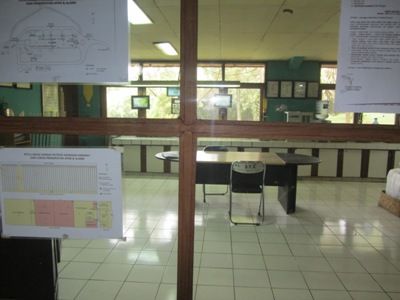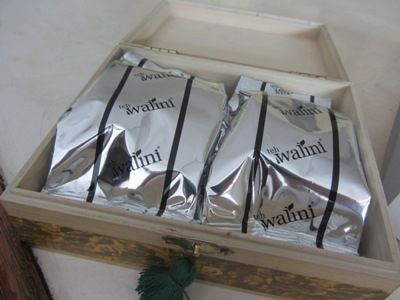Based on Wikipedia, Tea is an aromatic beverage commonly prepared by pouring boiling hot water over cured leaves of the Camellia sinensis plant. The term also refers to the plant itself. After water, tea is the most widely consumed beverage in the world. It has a cooling, slightly bitter, astringent flavour which many people enjoy.
In Indonesia, tea is easy to get from the low to high quality and the price also quite cheap because of that sometimes we take it for granted. I even didn't know before this visit how is the tea processing. So, the Walini tea factory was our next venue in this trip around Bandung, since we knew there's no tea plant or factory in Holland.
Actually we already wrote about the tea factory in this post but Aswin and I arrived late, so my friends already ended their tour. This was our chance to see how they process the tea leaves from the start. We arrived at the factory near lunch hour, although we kind of hungry but we agreed to take a little tour in the factory first. The fee for the tour was Rp. 15.000,- per person plus Rp. 30.000,- for the tour guide. I kind of confused because when I read last post it was cost Rp. 7000,- per person...hmm. Forget it, but it still reasonable price, we've got a cup of tea and a box of black tea after the tour.
The condition of building was rather not good and need to be renovated, the tour guide said that the factory was established during Indonesia was being governed by Dutch and renovated in 1990s but they still used the old machine. That's the reason why most of visitors were tourist from Holland around 60%, beside that were students from Bogor Institute of Agricultural (IPB). First, we were being taken to the building which used as place for weighing the truck that loaded with tea leaves and we also saw a lot of lumber and he said that it was used as fuel for the machine since the increasing of gas prices.
This factory in Ciater only produce black teas only, the tour guide said that every type of tea had different process. In the production of black teas, the halting of oxidization by heating is carried out simultaneously with drying. So, according to Wikipedia teas can generally be divided into categories based on how they are processed. There are at least six different types of tea: white, yellow, green, oolong, black, and post-fermented teas of which the most commonly found on the market are white, green, oolong, and black. Some varieties, such as traditional oolong tea and Pu-erh tea, a post-fermented tea, can be used medicinally.
And this is the tea processing based on Wikipedia: after picking, the leaves of Camellia sinensis soon begin to wilt and oxidize, unless they are immediately dried. The leaves turn progressively darker as their chlorophyll breaks down and tannins are released. This enzymatic oxidation process, known as fermentation in the tea industry, is caused by the plant's intracellular enzymes
and causes the tea to darken. In tea processing, the darkening is
stopped at a predetermined stage by heating, which deactivates the enzymes responsible.
Without careful moisture and temperature control during manufacture
and packaging, the tea may become unfit for consumption, due to the
growth of undesired molds and bacteria. At minimum it may alter the
taste and make it undesirable. So, just like aforementioned tea is traditionally classified based on the techniques with which it is produced and processed.
After the tour we had a cup of tea and box of Walini tea. I think the tour was great, now we know how it was made, then we're heading to our lunch venue.
Enjoy!
Walini Tea Factory
PTPN VIII
Ciater - Lembang
 |
| The White Tea: the Premium Tea |
 |
| In Front of the Factory: (From Left) Aswin, Anya, Icha, Christa |
 |
| Weighing Area |
 |
| Loading Area #1 |
 |
| Loading Area #1 |
 |
| Withering/wilting process:The Tea Leaves being Dried |
 |
| Hole where the Leaves are Going to the Next Process |
 |
| Take a Picture First: Cheese! |
 |
| Tea Processing #1: Disruption Stage |
 |
| Tea Processing #2: Oxidation |
 |
| Tea Processing #3: Drying Stage with Baking |
 |
| The Tea Sacks with Different Quality of Teas |
 |
| From left: tea with low quality, tea leaves for the tea bag (more fine grain), loose tea |
 |
| Ttake Picture Again, Smile! |
 |
| The Lab for Quality Test |
 |
| A cup of Walini Black Tea |
 |
| Boxes of Black Tea that was given after the Tour |
 |
| Variety of Walini Tea |
 |
| White Tea: It cost Rp. 300.000,- |
































0 comments:
Post a Comment